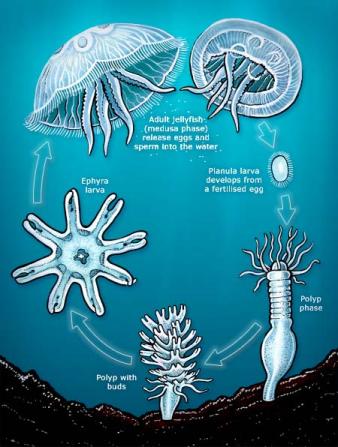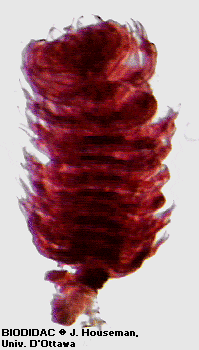Life Cycle
The medusa form of Cyanea capillata reproduces sexually and has separate sexes. The testes and ovaries occur on the floor of the pouches in the gastric cavity. The sperms of a male jellyfish (still as a medusa) are released through the mouth for fertilization. The eggs are then fertilized by the sperm which are delivered with the flow of the feeding current. After fertilization, the eggs are contained in the oral tentacles until the planula larvae is developed. This is a unique sexual characteristic of the Cyanea capillata when compared to the other Scyphozoans. The image on the right is a general overview of a Scyphozoan life cycle.
Once the planula larvae are fully grown, they detach from the medusa and settle down on the substrate as polyps. Once settled on the substrate, they are known as scyphopolyps. During this stage of the life cycle, they reproduce asexually by strobilation and then gain the name strobila. This form creates small disks that eventually break off and become ephyra which then grow into the adult medusa that the general public recognizes as the Lion's Mane jellyfish. The medusa stage in the life cycle is generally most abundant between April and May. The life span of a Cyanea capillata is typically around 1 year. Towards the end of their life and during reproduction they tend to gather into a sheltered bay near the surface. The image on the left is of an Aurelia, a close relative to Cyanea capillata, as a strobila. You can see the individual disks that break off and become a free living ephyra. If you think this life cycle is crazy you will be dumbfounded once you check out this fungus's (Amanita bisporigera) reproduction process.
Are you lost? Go back to my homepage!
